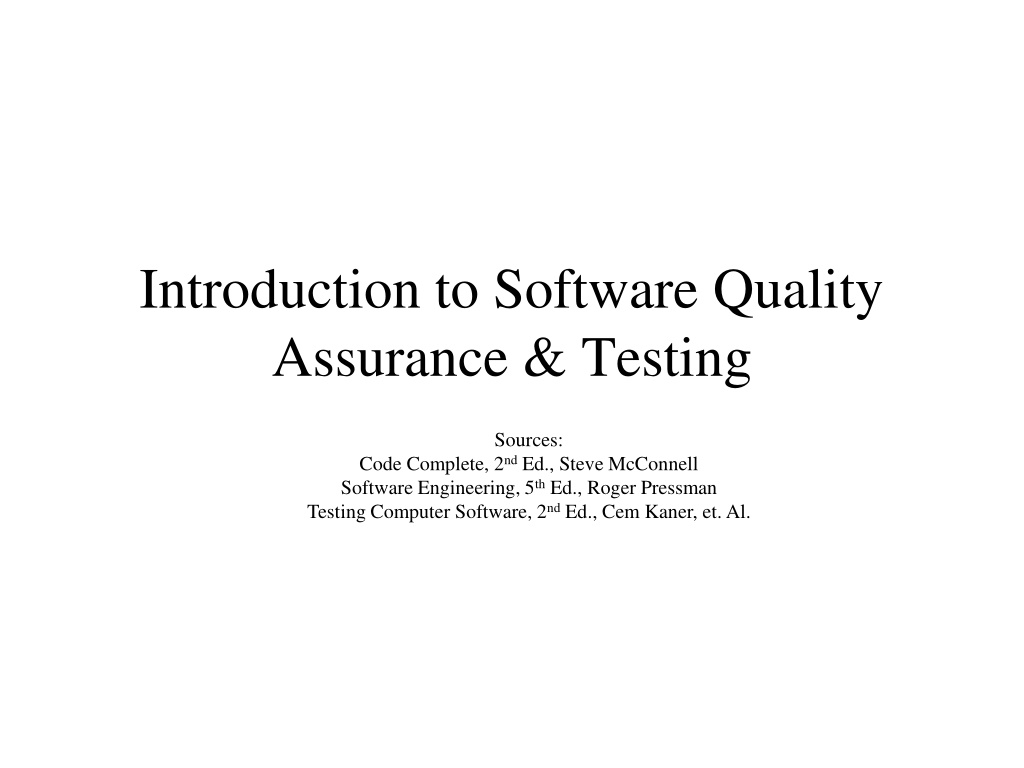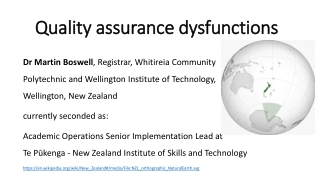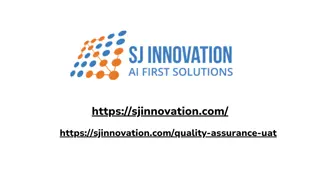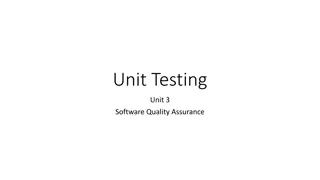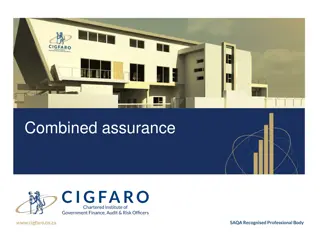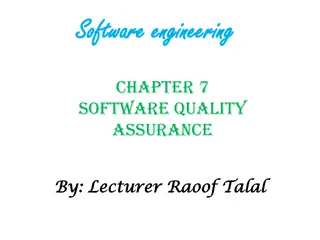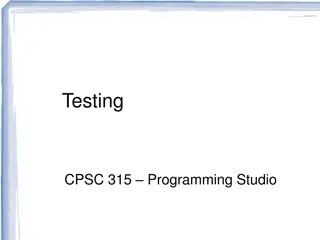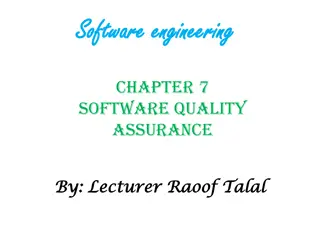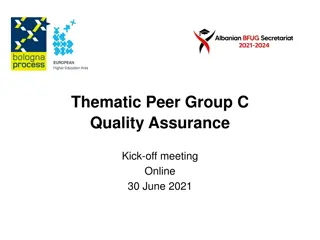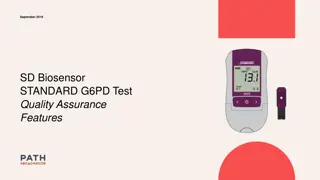Understanding Software Quality Assurance & Testing
Software Quality Assurance (SQA) aims to identify and rectify defects in software to meet user expectations. Defects can range from functional issues to security vulnerabilities, and the longer they persist, the costlier they become. SQA must be integrated throughout the software development life cycle to ensure optimal quality.
Download Presentation

Please find below an Image/Link to download the presentation.
The content on the website is provided AS IS for your information and personal use only. It may not be sold, licensed, or shared on other websites without obtaining consent from the author. Download presentation by click this link. If you encounter any issues during the download, it is possible that the publisher has removed the file from their server.
E N D
Presentation Transcript
Introduction to Software Quality Assurance & Testing Sources: Code Complete, 2nd Ed., Steve McConnell Software Engineering, 5th Ed., Roger Pressman Testing Computer Software, 2nd Ed., Cem Kaner, et. Al.
Software Quality Assurance The purpose of SQA is to find and report defects AND succeed in getting them fixed What is a software defect? Definition #1: There is a mismatch between the program and its requirements spec or functional spec This definition is fine if a requirements specification exists and is complete and correct (not always true) Definition #2: The program does not do what its end user reasonably expects it to do This definition always applies, even when there's no specification
Software Quality Assurance Categories of Defects Functional defects The program s features don t work as they should User Interface defects Usability problems Performance defects Too slow, Uses too much memory/disk space/bandwidth/etc. Error Handling defects Failure to anticipate and handle possible errors, or deal with them in a reasonable way Security defects Attackers can compromise the system and access sensitive data or other resources
Software Quality Assurance Categories of Defects Load defects Can't handle many concurrent users, can't handle large data sets Configuration defects Doesn't work on the required hardware/OS/browser configurations Race conditions Behavior depends on the interleaving of concurrent activities Documentation defects User manuals or online help isn't clear, complete, well-organized
Software Quality Assurance The longer defects remain in the system, the more expensive they become The cost of a defect grows dramatically the longer it remains in the system What is the cost of a defect in the requirements specification if it s found found during requirements phase? during implementation? after product ships? SQA should be performed throughout the software development life cycle It's not something you do only at the end after everything's pretty much done
Verification & Validation Validation Build the right product Those activities that attempt to determine that customer needs can be met by a product Verification Build the product right Transformational activities that are performed at each step of the product life cycle Evaluating at each stage of the life cycle to ensure the software meets the requirements Focus Completeness, Consistency, Feasibility, Testability
Software Quality Assurance The two primary SQA activities: Technical Reviews Software Testing
Technical Reviews A review is a meeting where a work product is reviewed by a small group of people who are qualified to give feedback, find problems, suggest improvements, etc. Anything can be reviewed: requirements spec, functional spec, design, code, test plan, user documentation Reviews range in formality In the morning, spend some time reviewing your work of the previous day Informal requests for feedback from peers Pair programming Formal meetings, pre-scheduled, specific invitees, prior preparation Problems found during reviews are fixed, resulting in improved quality Reviews are the most effective QA technique, both in terms of cost and number of defects discovered
Review Meetings Review the product not the producer Set an agenda and keep it Limit debate and rebuttal Enunciate problem areas but don t try to fix anything Take written notes Limit the number of participants Insist upon advance preparation Develop a checklist Allocate resources and time schedules Conduct meaningful training
Software Testing Testing is the process of detecting errors by running the actual software and verifying that it works as it should Test cases, Expected results, Actual results Testing is by far the most popular QA activity (but not the most effective) Formal technical reviews are cheaper and more effective than testing, but are often ignored Research has shown that all forms of testing combined usually find less than 60% of the errors present A typical project might expend 50% of its resources on testing
Software Testing Exhaustively testing software is not feasible The number of possible input combinations is effectively infinite The number of unique paths through the code is effectively infinite You might not live long enough to exhaustively test a non-trivial software system We must do partial testing because we only have enough resources (time and money) to run relatively few test cases Partial testing can never prove the absence of defects If the system passes all your test cases, there could still be defects, you just need more or better test cases to find them
Software Testing Effective testing lies in intelligently choosing the relatively few test cases that will actually be executed Test all requirements and features defined in the requirements spec. and functional spec. Focus on scenarios that users are likely to encounter in practice Test cases should not be redundant (i.e., each one should follow a different path through the code) Analyze the program s design and code to find potential weak areas Analyze all points at which data enters the system and look for ways to attack it Code coverage
Software Testing Approaches for test case design are generally divided into two broad categories: Black Box Testing and White Box Testing Black Box Testing The tester has limited knowledge of the inner workings of the item being tested Test cases are based on the specification of the item's external behavior White Box Testing The tester has knowledge of the inner workings of the item being tested Test cases are based on the specification of the item's external behavior AND knowledge of its internal implementation
Software Testing Testing is unlike other software development activities because the goal is to break the software rather than to create it Effective testing requires the assumption that you will find defects Effective testing requires that you want to find defects If you think you won't find defects, or you don't want to, you will have set up a self-fulfilling prophecy Testing by both developers and an independent testing group are essential They have different perspectives and motivations They do different kinds of tests (developer does white box, test team does black box), which tend to discover different types of defects
Software Testing Defects are not evenly distributed (i.e., they tend to cluster) Research has shown that: 80% of a system's defects are found in 20% of its code 50% of a system's defects are found in 5% of its code There is a high correlation between bugs and complex code. Use tools to measure code complexity, and focus testing on those modules with the most complex code One goal of testing is to identify the most problematic modules Redesign may be needed if there is an inherent design flaw Or, replace buggy module with a third-party library/product
Software Testing How many defects should you expect to find? It depends on your development process Most projects experience between 1 and 25 errors per 1000 LOC The Applications Division at Microsoft reports 10 to 20 errors per 1000 LOC, with 0.5 errors per 1000 LOC in released products
Software Testing Automation of test cases is essential to make frequent re-running of test cases feasible A lot of the interesting testing work is found in inventing and creating ways to automate test cases (i.e., create programs whose purpose is to test other programs) Automation requires a lot of software design and implementation (sometimes called Test Engineering ) Some tests are difficult to automate and must be run manually
Unit Testing Exercise a specific module in a controlled environment Typically involves Scaffolding Stubs and drivers Stubs Modules below a unit to mimic behavior of dependent modules Drivers Modules above a unit that drive the unit in the same fashion its calling modules do Involves both white box and black box testing
Integration Testing After unit testing put them together to do testing Top down or bottom up Tester needs to understand the behavior of integrated modules Module hierarchy can help
System Testing Execution of the entire system Does it conform to the overall system requirements Depends on the document May be simulated Depends on accuracy of the simulator Tests Functionality Performance Reliability Usability
Regression Testing Check to see that an update does not re-introduce errors Check Functionality typically black box tests Architecture gray box tests (some knowledge of inner workings) Typically a large suite of tests All functionality All changes Needs to be automated
Regression Testing Build results for version x Test data Build tests for version x Run tests for version x Verdict Compare
Automating Regression Testing Challenging What parts of program output should be checked? Simple but annoying issues Use of dates in output Changes in whitespace Format changes Lead text changes Answer Don t use complete output Just extract the relevant information
Regression Testing Keep it updated! Bug fixes tests to ensure they stay fixed Functionality additions Platform changes Etc. If you branch the code, you must branch the regression tests
Formal Verification In addition to Technical Reviews and Software Testing, Formal Verification is another approach to QA Create a formal model of the system Some kind of automaton (i.e., state machine) or other mathematical abstraction that precisely captures the system s behavior Check the model by formally proving that it implements the desired behavior Automated theorem proving systems are often applied Or, prove that the model does not behave correctly, thus revealing a defect Historically, formal verification has been expensive and limited to relatively small programs, but techniques are improving all the time. Challenges include: Complex systems are hard to formalize State space explosion: real systems have so many possible states that proving things about them is hard Ensuring that the model accurately captures the system s behavior Making it accessible to people who aren t formal verification experts
